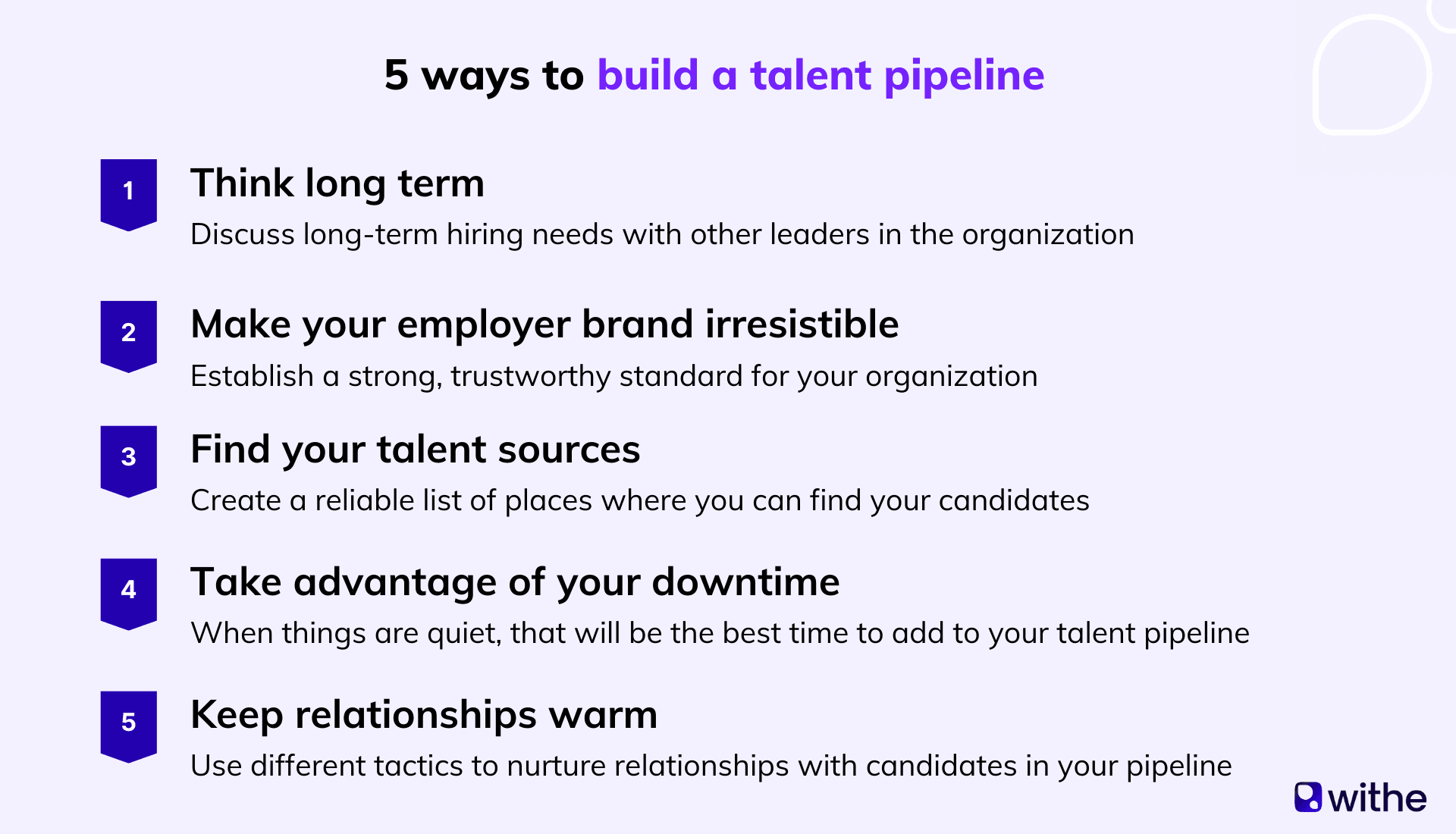Leverage Withe's hiring event platform
Streamline your seasonal and high-volume hiring process and hit your hiring targets.
When your company is small and starting out, it makes sense to focus on each new role individually. You search for potential candidates, speaking to each one, and determine which is the best possible fit for the role. However, once the company grows, that approach quickly becomes unscalable.
With more and more roles to fill, taking a reactive approach to hiring can make recruiting teams slow and inefficient. And with candidates only spending a handful of days on the market, you can’t afford to do that.
So, what’s the alternative? Taking a proactive approach and building a talent pipeline is a great way to have a roster of potential candidates you can check in with any time you have a role open. This reduces time to hire, helps you build relationships with better candidates earlier, and ultimately improves the candidate experience. (A win-win.)
In this piece, we’re taking a closer look at what a talent pipeline is and giving you five things to do to build one that works for your business.
Leverage Withe's hiring event platform
Streamline your seasonal and high-volume hiring process and hit your hiring targets.
What is a talent pipeline?
Let’s start with a definition. In short, a talent pipeline is a selection of candidates that you’ve determined are worthy of being considered for future openings. These are candidates that are evaluated and engaged with even when there isn’t an open role so that when a position does open up recruiters can tap into that pool.
When we talk about a reliable talent pipeline, we mean one that has applicants that are engaged with the employer brand and are actively interested in pursuing opportunities at the organization. The people in this pipeline should be known to recruiters in some way — either they were a finalist in past openings, or someone that attended informational interviews and shared their resume during that process.
Since you have these existing relationships, you don’t have to spend the time you would usually spend with candidates teaching them about the company or your values. They can be fast-tracked to the next stage of the hiring process.
What is the difference between a talent pipeline and a talent pool?
The terms “talent pipeline” and “talent pool” are often used interchangeably, but they do actually mean different things. The talent pool is the group of candidates that apply for or are interested in roles at your company. Meanwhile, the talent pipeline is a subset of the talent pool, and it includes people that have already established a relationship with recruiters either through a previous application, a networking event, or an informational session.
What are the benefits of having a talent pipeline?
There are various good reasons to have a talent pipeline in place. An effective and well curated talent pipeline:
- Reduces time to hire as it provides you with a selection of pre-qualified candidates that may already be interested in your employer brand.
- Improves your access to qualified talent as your recruiters are actively spending time qualifying candidates even when there isn’t a role open.
- Enhances the candidate experience by giving candidates the opportunity to build a stronger connection with recruiters and the broader employer brand.
- Lowers hiring costs in the long run as your team is less likely to need to run extended campaigns to attract qualified candidates.
- Establishes a connection with passive candidates that may be re-approachable down the line when you do have a role open.
Each of these benefits supports recruitment teams that are being continuously tasked with being more efficient while dealing with a competitive talent market.
5 best practices for building a talent pipeline
Building a reliable talent pipeline takes a concerted effort that’s equal parts proactive and deliberate. Here are some of the things you can do to get it right.
1. Think long term
The first thing you’ll need to do is get a sense of the company’s hiring needs. Go to other business leaders and talk to them about the growth roadmap for the organization. Here are some of the questions you can take to them:
- Where is the company going in the next six months, one year, or two years?
- Are you expanding to new locations?
- What are the growth plans for specific departments? Will there be any reorganization initiatives?
- What are the company’s plans in terms of having a remote workforce?
These are ongoing conversations that need to happen across the company. Consider setting up quarterly or biannual meetings with department heads to get any updates that might inform your talent pipeline needs.
2. Make your employer brand irresistible
In parallel to finding out your long-term hiring needs, it’s also worth spending time and effort on building a strong and recognizable employer brand. Not only will this help build trust with the candidates you do speak to, but also create more organic interest in your company, making it easier to add new interested parties to your talent pipeline.
This doesn’t just mean sprucing up the look and feel of your messaging, it also means creating a candidate experience that delights candidates and makes advocates out of them. Develop standards for interviewing, hiring, and building relationships with candidates, and make sure everyone knows about them.
Plus, don’t forget to talk about what makes your hiring process different. Do you use on-demand video interview software to streamline conversations with high-volume candidates? Tell them! Have you reduced the time it takes to review an application? Let them know that, too.
People dislike long and arduous hiring processes, so they’ll be much more likely to build a relationship with your employer brand if they know you have their experience in mind.
3. Figure out where the talent is
The next important step is to uncover the best sources for candidates that you can add to the talent pipeline. These may overlap with some of the sources you use to supplement your in-time hiring approach, including:
- Referrals: Have your current employees refer their friends and peers even when there isn’t a role available. A referral program that rewards employees can be a great incentive for this.
- Networking events: Take the time to attend industry events where you can speak with top talent or work with other departments to host corporate events that bring in potential candidates.
- Dedicated recruitment campaigns: This can include graduate program partnerships or roadshows to different universities and colleges. These campaigns can help supercharge your talent pipeline with quality entry level candidates.
Lastly, you should also keep tabs on the people that are succeeding in your industry. Are there thought leaders that are publishing content in industry publications? Has anyone won an industry award? Is there someone that shares their insights on LinkedIn often? These are people you can establish an informal relationship with, letting them know about where the company is headed and sharing any future roles that might be a fit for them.
4. Take advantage of your downtime
This one might feel like common sense, but it’s a key part of building a successful talent pipeline. The best time to work on filling your talent pipeline is when things are quiet. Even if you’re in the midst of a hiring freeze, or you just finished bringing in the last batch of new hires, that might be the perfect time to start looking for new potential hires. (That’s the proactive element of this process.)
Take this time to build relationships with potential applicants: conduct informational interviews, update past applicant files and determine whether they are still interested in a role, forge new relationships with professional organizations, and create return opportunities for past employees.
5. Keep relationships warm
This leads us to our next step: filling the talent pipeline is (and should be) an ongoing initiative. It requires nurturing the relationships in the candidate pool so that applicants remain engaged and interested in the employer brand.
Use a light touch, but be effective. Take a personalized approach that accounts for the candidate’s interests. Even if you don’t have an available role, you can share content that you know might be appealing to them.
As you do this, here are three core principles you should keep top of mind:
- Be open and transparent — this helps build trust.
- Respect your candidate’s time.
- Treat the candidate as a person, not a number.

The true value of a reliable talent pipeline
The benefits to having a full talent pipeline are extensive. Above all, it vastly improves the efficiency and effectiveness of your recruiting efforts, making it much more likely that you’ll get the best possible candidate into any role that comes up.
At Withe, we’re helping high-volume recruiters become more effective with our on-demand video interview software. Learn how on our home page.




